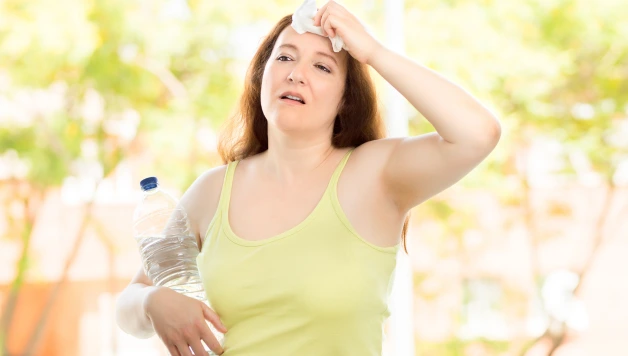Key Takeaways:
- VMS (Vasomotor Symptoms) in menopause refer to hot flashes and night sweats due to hormone changes.
- VMS arises from estrogen decline, disrupting body temperature regulation.
- VMS affects daily life, sleep, and emotions, emphasizing the need for effective management.
- Solutions include hormone therapy, lifestyle adjustments, and alternative treatments for symptom relief.
Are you curious about VMS Menopause? Are you wondering what vasomotor symptoms of menopause mean? If you’re seeking clarity on this topic, you’ve come to the right place. Let’s embark on a journey to explore the world of VMS Menopause together and unravel its significance.
What is VMS Menopause?
VMS Menopause, which stands for Vasomotor Symptoms of Menopause, is a term used to describe a specific set of physical sensations many women experience during the transitional phase of menopause. This phase signifies the cessation of menstrual periods and marks a significant change in a woman’s reproductive life.
Understanding Vasomotor Symptoms:
At the heart of VMS menopause are vasomotor symptoms. These symptoms manifest as sudden, intense waves of heat engulfing the upper body, often accompanied by rapid skin flushing. This phenomenon is commonly known as a hot flash. Imagine feeling like your body’s internal thermostat suddenly went haywire, causing a surge of heat that leaves you sweating and uncomfortable.
Why Does VMS Menopause Occur?
To understand why VMS occurs, we must delve into the role of hormones, particularly estrogen, in a woman’s body. Estrogen, produced by the ovaries, plays a crucial part in regulating various bodily functions, including temperature control. As menopause nears, the ovaries produce reduced estrogen levels, leading to a hormonal shift that disturbs the body’s temperature regulation. This imbalance is at the core of the vasomotor symptoms experienced during menopause.
The Impact of VMS Menopause on Daily Life:
VMS menopause can have a profound impact on a woman’s daily life. The sudden and unpredictable nature of hot flashes can lead to discomfort, embarrassment, and even disruption of daily activities. Imagine being in the middle of an important meeting or social event, only to be engulfed in a wave of heat that leaves you feeling flushed and sweaty. Such experiences can be distressing and may affect a woman’s overall well-being.
Managing VMS Menopause:
While vasomotor symptoms are a natural part of the menopausal process, some strategies can help manage and alleviate their impact. Here are some practical steps to consider:
- Stay Hydrated: Staying well-hydrated supports maintaining body temperature and can lessen the severity of hot flashes.
- Healthy Eating: Avoiding triggers such as spicy foods, caffeine, and alcohol can help minimize the frequency and severity of hot flashes.
- Regular Exercise: Regular physical activity promotes overall health and can help regulate hormones and manage symptoms.
- Stress Reduction: Practicing relaxation techniques such as meditation and yoga can help reduce stress and decrease the likelihood of experiencing hot flashes.
- Cooling Techniques: Utilize cooling fans, apply cold packs, or take cool showers when a hot flash strikes to provide immediate relief.
Consulting a Healthcare Professional: Treatment Options
If vasomotor symptoms become particularly bothersome or disruptive, seeking guidance from a healthcare professional is essential. A healthcare provider can offer personalized advice and recommend various treatment options based on your needs and medical history.
Hormone Therapy:
Hormone replacement therapy (HRT) is a common approach to managing vasomotor symptoms. This therapy includes the administration of hormones, including either estrogen alone or in combination with progestin. It helps in rebalancing hormone levels and reduces the frequency and intensity of hot flashes. However, hormone therapy may not be suitable for everyone. Thus, discussing with a healthcare provider is crucial.
Non-Hormonal Treatments:
Non-hormonal treatment options are available for those who cannot or choose not to undergo hormone therapy. Certain medications, such as certain antidepressants and anti-seizure drugs, have been found to reduce hot flashes in some individuals effectively.
Natural Remedies:
Some women relieve vasomotor symptoms through natural remedies, including herbal supplements, acupuncture, and dietary modifications. Undoubtedly, these methods might provide relief. But, consulting a healthcare expert before attempting any natural remedies is crucial. It will help in ensuring their safety and efficacy.
Embracing the Journey:
Navigating through VMS menopause may present challenges, but it’s important to remember that you’re not alone. Countless women have experienced or are experiencing similar symptoms. Receiving support from loved ones and healthcare providers can significantly impact the management of vasomotor symptoms and your overall well-being.
Conclusion:
VMS menopause, or vasomotor symptoms of menopause, refers to the physical sensations experienced by many women during the transitional phase of menopause. These sensations, often manifested as hot flashes, are a result of hormonal changes that disrupt the body’s temperature regulation. While VMS menopause can be disruptive, strategies and treatments are available to help manage and alleviate these symptoms.
Remember, seeking guidance from healthcare professionals is essential. Meanwhile, embracing a proactive approach to your well-being can empower you to navigate this phase with greater ease and comfort.









